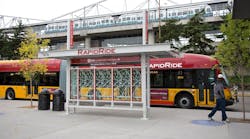VIA Metropolitan Transit Board secures $102 million from Advanced Transportation District for VIA Rapid Silver Line
The VIA Metropolitan Transit Board of Trustees for the Advanced Transportation District (ATD) approved an agreement with Bexar County on Aug. 27 that secures $102 million from ATD revenues to fulfill the agency’s local funding obligation for the VIA Rapid Silver Line, a move that now allows the agency to proceed in seeking a 50 percent match in federal funding for the $289.2 million project.
The agreement by the board was the final step in a process that began about a year ago when VIA Metropolitan Transit officials began discussions with Bexar County Judge Peter Sakai, Bexar County Manager David Smith and others to develop a funding partnership that would tap into sales tax revenue collected by the ATD and held by the county.
The Silver Line will connect the area near Our Lady of the Lake University on the west side to the Frost Bank Center on the east side, passing through downtown. Service is expected to begin in 2029. The Silver Line is the second planned Advanced Rapid Transit corridor in the region. The Green Line, set to open in 2027, will run from the area near the San Antonio International Airport, down San Pedro Avenue, through downtown and to Steves Avenue on the south side. The corridors are designed to connect more people to more destinations in less time.
“The agreement between Bexar County and the Advanced Transportation District is a crucial step because it secures the local funding needed for VIA to attract federal dollars, which we expect to cover 50 percent of the project cost,” said VIA Metropolitan Transit President and CEO Jeffrey C. Arndt. “We’ve worked closely with Judge Sakai, commissioners and David Smith to reach the agreement and I look forward to our board taking up the issue for a vote on Tuesday.”
The VIA Rapid corridor projects are expected to collectively receive about $416 million in federal dollars, marking the first time in San Antonio, Texas, history that the region has qualified for Capital Investment Grants from the Federal Transit Administration.
VIA Metropolitan Transit says the projects qualify for federal funds, in part, because they meet the requirement of having dedicated transit lanes along at least 50 percent of their routes. VIA Rapid will also enhance safety for all people traveling through the corridors, regardless of mode of transportation. Designed to move more people faster and farther, VIA Rapid includes off-board fare collection, transit-friendly traffic signals, raised boarding platforms for better accessibility and 10-minute weekday and 15-minute weekend frequency, making it the most frequent service in the VIA Metropolitan Transit system.



